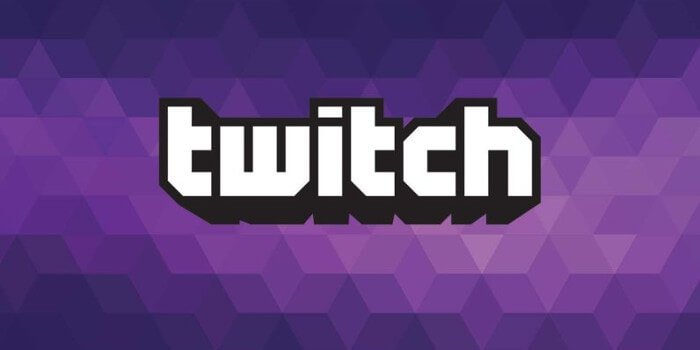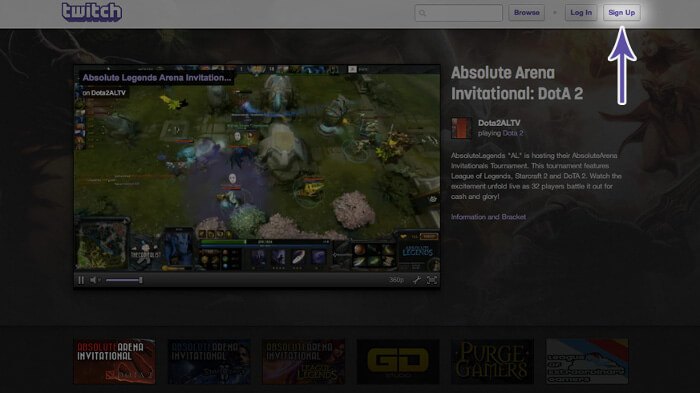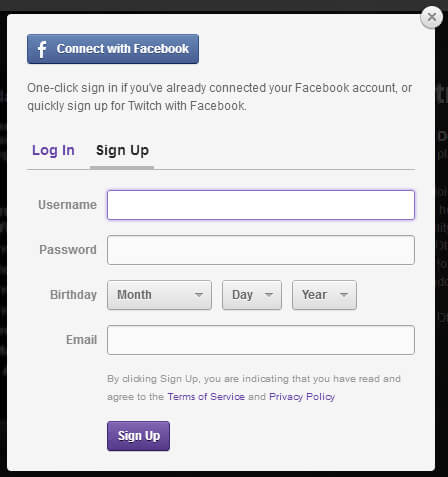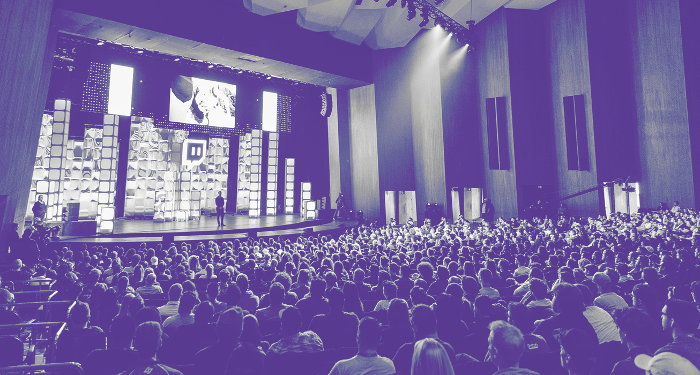
Have you ever considered how awesome it would be if you could make playing video games your career? Well, you can. People are making serious money on Twitch these days. We’re talking anywhere from a few extra bucks to thousands of dollars a month just to play video games.

Are You Ready To Work Your Ass Off to Earn Your Lifestyle?
Are you tired of the daily grind? With a laptop and an internet connection I built a small website to generate income, and my life completely changed. Let me show you exactly how I’ve been doing it for more than 13 years.
Though it sounds fun (and it can be), making good money on Twitch is not always easy. Everyone starts out streaming to no one, which can be pretty demoralizing! On top of that, taking breaks or not streaming consistently can cause your views to drop pretty rapidly.
Creating fun, engaging, and profitable content consistently is an issue for any creator though, no matter which platform you use. I feel the same pressures as a writer and blogger. If you’ve been watching Let’s Plays on YouTube, then you know it’s a problem YouTubers as well.
What I want to lay out in this article is how to grow an actual business on Twitch. In my opinion, making a few bucks streaming isn’t worth it. If I go for something, I go hard, and if you want to make money with Twitch then you might as well do it right.
How To Make Money With Twitch
Are you brand new to streaming? Read this Twitch FAQ to make sure you’re ready.
- How to Get Set Up
- Account Creation
- Proper Equipment
- You’re Set Up, Now What?
What is Twitch?

Founded in 2005, Justin.Tv, named for its founder Justin Kan, was originally intended to be an around the clock life broadcasting service. After receiving mixed reviews, Justin enabled the viewers the opportunity to set up their own broadcasting channels. This would, in turn, give birth to what we now know as Twitch.Tv.
In 2014 Twitch Interactive was sold to Amazon.com for $970 million and was ranked 4th in peaked online traffic behind only Apple, Google, and Netflix.
Twitch is a streaming platform where gamers are allowed to stream live video of their gameplay in front of an online audience.
Gaming publishers and media outlets also have their own Twitch channels and communities where they often provide potential consumers with a small peek behind the curtain of their next featured product.
Twitch.Tv is also host to many competitive and charity events that include tournaments, gaming marathons, and eSports.
1. How to Get Set Up
If you’re looking to make money streaming, there are a few things you’ll need to do in order to be properly setup on Twitch. You’ll need to make sure that you have the proper equipment and of course, an account. Seeing that you can create an account for free, we’ll start there.
Account Creation
By creating an account on Twitch, you’ll be allowed to interact with other broadcasters and their communities via chat, follow your favorite live streamers and broadcast your own gameplay to the Twitch community.
To sign up for a Twitch account, you’ll need to go to the website at http://twitch.tv. Once there, select the “Sign Up” button on the top-right portion of the page.

This opens the Login / Sign Up screen. You’ll want to fill out the form on the right-hand side, which requires you to provide a username, password, email and your date of birth.
If you’d rather not have to fill out the form, then you may also sign up for a Twitch account by using your Facebook account. Simply click the “Connect with Facebook” button and you’ll be on your way.

Proper Equipment
Twitch is first and foremost a live streaming platform for gamers. Therefore, it should be a no-brainer that you’ll want to have either a PC or gaming console. If you opt for the latter, then you’ll need to purchase a capture card in order to live stream.
If you choose to stream via a personal computer, you’ll need to ensure you meet the requirements for the output you’re attempting. A higher end rig is not necessary for streaming but the more performance you can get out of it, especially in relation to frames per second (fps), the better the viewing quality.
The recommended minimum specifications that Twitch offers are as follows:
- CPU: Intel Core i5-4670 or AMD Equivalent
- MEMORY: 8GB DDR3 SDRAM
- OS: Windows 7 Home Premium
You’ll also need to acquire broadcasting software in order to stream on Twitch. A few suggestions would be:
Aside from the obvious, it may also benefit you to purchase both a webcam and a microphone. It allows for building that necessary rapport with your audience when they’re both able to see and hear you. Providing audio commentary for your gameplay is also a boon to viewers and highly recommended.
If you want to make serious money with twitch, it is going to take a bit of an investment. You won’t have to spend thousands of dollars to get set up, but there are going to be some minimal costs, unless you already have this equipment.
2. You’re Set Up, Now What?

Twitch channel streams are 24-hour streams. This doesn’t mean that you’ll need to be playing video games all day, but your channel is there for viewers to watch. You’re given the opportunity to upload pre-recorded videos to your channel, but the true purpose of Twitch is to provide users with access to live streams of gameplay.
For broadcasters, Twitch can be something on the side, a complement to a career in e-Sports (competitive gaming), a fun hobby or a legit full-time job.
How you go about broadcasting depends entirely on how you choose to play and on the specific equipment you’re using. Whichever way you decide, the gaming community at Twitch is there to offer plenty of online support via chats and forums that can be a great resource for anyone just starting out.
When you start out, keep in mind that most people being by streaming to an empty room. It’s pretty demotivating, and puts you in a catch-22 situation.
How can you be animated and funny while no one’s watching? Should you only engage when you have viewers? What if you only have two viewers, is it worth the effort?
The answer is that YES, you need to be engaged to matter your audience size. People will come and go, so you need to be on-point no matter who’s watching.
6 Steps To Making Money With Twitch
The first step after setting up is to get people to want to watch you (and stick around). This is usually the most difficult part of Twitch streaming. You can’t just play any old game, streaming when in the mood, and attempt to pull in viewers organically. If your goal is to monetize (and it should be since you’re reading this article) then this approach will take far too long to establish any kind presence.
If you want to make money, you’re going to have to get a bit more creative.
1. Choose The Right Game
When choosing your game, you need to be strategic if you want to attract viewers. Gaming reviews are extremely powerful online, both for the companies selling the game, and for the reviewing putting out the content. Opting for an older or unpopular game will likely net you very minimal results. However, playing a more popular game can have you drowning in a sea of competition for viewers.
As of writing this article, the top 5 games being streamed on Twitch are:
- League of Legends (LoL)
- Fortnite
- Dota2
- Player Unknown Battlegrounds (PUBG)
- Hearthstone
Your best bet is to browse Twitch and look out for the games with a number of streamers ranging between 10 to 20. This offers you a good chance that the game itself is ranked highly on Twitch while also giving you room to shine and attract those coveted viewers.
2. Connect with Popular Streamers
Going at it alone is admirable but in any business, it’s not necessarily what you can do, but who you know. Forming bonds within the Twitch streamer community can garner exposure, and get helpful tips and strategies for your stream that you may not have thought of otherwise, and more followers of your own.
Engaging in conversation in other streamer’s chat rooms can lead to great results. If you seem knowledgeable, interesting, or an all-around decent person, other viewers may decide to follow you on your own channel. Becoming friends with the streamer can also lead to massive exposure. They may choose to host your channel leading to even more potential viewers and followers.
The current top 5 most followed streams are:
- Ninja (FortNite player and streamer)
- Summit1g (Currently playing FortNite)
- Riotgames (League of Legends organization)
- Shroud (PUBG player and streamer who plays for the eSports organization Cloud9
- Syndicate (Recently FortNite and IRL as well)
3. Leverage Social Media

Often overlooked, social networks can significantly aid you in building your brand. Many successful streamers use apps such as Twitter, Instagram, and Facebook to keep fans informed and up to date on their comings and goings of daily life. This allows you to connect with them on a more personal level.
4. Grow Your Community

In order to grow, increasing your regular viewers is very important. However, not all viewers are created equal. Those who frequent your channel could be:
- Trolls that harass you and the other followers in the chat
- Quiet lurkers who never interact with you or your chat
- Fair-weather viewers that only show up for giveaways and free stuff
- Bots
In order to acquire the right kind of viewers, followers, and potential subscribers, you’ll want to go about it in the proper way. Things you should never do to attract viewers:
- Use Viewbots (programs that generate a false viewer count)
- Pay outside websites to grow your channel
You can catch more flies with honey than vinegar is an apt adage for this situation. If you want to grow your community, you’ll need to branch out. A few things that will help with growth are:
- Interacting with other streamers and sharing the love by hosting them on your channel
- Join a streaming community of like-minded individuals
- Holding giveaways to loyal followers. Try to keep these to a minimum to not attract the freeloaders mentioned above
- Uploading your videos to other platforms like Vimeo or YouTube
- Posting your thoughts and opinions on gaming websites (under a recognizable handle)
5. Engage Your Audience
Twitch actually houses a few different kinds of streamers on its platform. The bulk is of course filled by gamers, but what about the other folks who can’t dedicate hours to just streaming video games? Where do they fit in?
Over the years Twitch has added more outlets for those wanting to stream for income that doesn’t necessarily fit the gamer mold. There are those like JimLee who dedicate their Twitch streaming time to hand drawing illustrations live. Others such as Jae_Bunny have turned their Twitch stream into more of a cooking show. These particular streamers can often be found in the Creative section.
Additionally, sometimes a streamer doesn’t have the luxury of sitting at home in front of their preferred gaming platform and stream for the masses. This is where the IRL section comes into play. Twitch streamers can choose to stream themselves doing everyday things in their daily lives.
Each of these options is still perfectly viable and are able to earn money through tips, donations, and the programs offered to gaming streams.
6. Drive Traffic With A Website
Building out a website is a very under-utilized tactic within the Twitch, gaming, and streaming communities. Very often, streamers will pigeonhole themselves as just a “video person”, and completely ignore all other aspects of growing their brand.
This is fine if you already have a YouTube audience and are just moving to Twitch. It’s how H3H3 were able to move so successfully from YouTube to Podcasting after the “adpocalypse”.
But what if you’re starting from scratch?
Websites attract a whole different audience. They are the people searching for written content online, and you can leverage your website to send traffic to your Twitch channel.
It’s actually pretty easy to build a WordPress website these days, and you can have the bulk of the work done in less than 5 minutes. After that, you need to create content, like articles, which get found in Google. The topic of your website should be something related to your gaming channel, so the audience matches.
Here’s a perfect scenario.
Let’s say you write a review of No Man’s Sky, and say it’s garbage. You then recommend a much better game, Star Citizen or Elite Dangerous. You can then send those visitors to your channel to watch you play these games.
The connection could be indirect too. You could post a review of your favorite gaming chair, or just provide commentary about what you think about Ninja’s latest stream. Your gamer blog could be about any niche focus you want, and then could send people to your Twitch channel.
As a bonus, you can also monetize your website content with display ads (Google Adsense), and affiliate programs. This diversifies your revenue, and provides you with income to fund better equipment for your Twitch channel.
Twitch FAQ
These FAQ are divided into four sections.
- Section 1: The Fundamentals of Twitch
- Section 2: Twitch Affiliate & Twitch Partner
- Section 3: Networking & Growth
- Section 4: Monetization and Expansion
Section 1 – The Fundamentals of Twitch
1. What is Twitch.tv?
Twitch.tv is a broadcasting platform that allows content creators to livestream, upload videos and publicize their experiences. Whether it’s playing games, competing in esports, drawing artwork or just chatting there are hundreds of possible options out there.
It was founded in 2005 as Justin.tv and was sold to Amazon in 2014. The platform allows players to view their favorite channels, subscribe to their favorite creators and even let their streamers earn money through the affiliate and partnership programs.
It is currently the largest livestreaming platform out there but recent contenders include Mixer YouTube and DLive.
As of May 2019, it had 140 million unique viewers a month with 15 million active users daily and 2.2 million people broadcasting monthly around the world.
There are currently 248,000 affiliates and 27,000 partners.
2. What do I need to start streaming?
Streaming on Twitch is easy! All you need is a computer, microphone and games to play!
You do not need to have a high-end computer though there are minimum requirements in order to ensure smooth FPS and decent viewing quality.
The requirements for these are:
- CPU: Intel Core i5-4670 or AMD Equivalent
- MEMORY: 8GB DDR3 SDRAM
- OS: Windows 7 Home Premium
A simple microphone will work, many beginner streamers use their gaming headset microphones. However popular brands that many streamers use include:
- Blue Snowball
- Blue Yeti
- Razer Seiren
Do you need a webcam? Not necessarily, however it is substantially more difficult to gain traction without viewers being able to see you. There are a range of cameras available however the most popular cameras are:
- Logitech C920
- Logitech C922
- Razer Kiyo (Which also comes with a built-in light ring)
Finally, if you wish to stream from console, you can use the in-built applications on the console software. Most streamers invest in a capture card though to give the full flexibility of customization available on the PC that the app does not provide.
The most commonly used capture cards are:
- Elegato HD60 capture card
- Razer Ripsaw HD Capture Card
3. What is the best software to use?
There are many options available to streamers. A full list can be found here:
https://help.twitch.tv/s/article/recommended-software-for-broadcasting
The most popular software used is:
- Streamlabs OBS
- OBS
- X-split
Streamlabs OBS is used by 70% of streamers on PC and is popular for the fully customizable overlays, widgets and chatbot options that can be fully integrated into the stream. The software also tracks follows, hosts and other events so that you never miss a thing even when offline.
It also provides you with channel analytics. It also allows the option of simultaneous recording and broadcasting.
Comprehensive guides are available on how to set this up on YouTube.
4. What is the best content to stream?
There is no right answer to this!
You should stream what you would be happiest streaming. Some people stream art, others stream one game whilst many streamers showcase a variety of games.
There are however some things to be aware of when choosing what to stream. Some games which have many viewers will be harder to be noticed in than those with fewer viewers.
Opt for games with between 10-20 viewers or that are not overly saturated. Games with a heavy esports presence are likely to be ineffective as these are often dominated by professional players who automatically have a following.
If you need help with deciding what to stream Twitchstrike.com can help with providing statistics for the possibilities you wish to pursue.
These figures should not be taken as hard evidence your game choice will do badly but can help see where you may get the most viewers.
What is important to remember is that if you are not happy streaming a certain game or content, this will come across in your streams and may put people off, losing you both subs and viewers as a whole.
Section 2 – Twitch Affiliate & Twitch Partner
1. How do I get Twitch Affiliate?
Twitch affiliate is the first step to earning revenue on Twitch.tv and a goal many streamers strive to get too. As of May 2019, there are approximately 248,000 streamers at affiliate.
To reach affiliate, streamers must reach a set of goals over a 30-day period:
- Reach 50 followers
- Stream for 8 hours
- Stream on 7 different days
- Reach an average of 3 viewers.
The final requirement on this list is often the one that causes the most issue for those seeking affiliate status. For this to requirement to be met, streamers must have 3 concurrent viewers on average over a 30-day period. This includes raids and hosts. You can track your average viewers through your creator dashboard and analytics.
Once you are accepted as an affiliate, you will receive an invite from Twitch to participate in on-boarding. There streamers must provide details for tax and payment in order to be able to generate revenue from subscriptions and bits.
Affiliates also have access to emotes, subscriber badges and bit badges for their chat channel.
2. What is Twitch Partner?
Twitch Partner is the elite program of Twitch.tv and is currently a position held by 27,000 streamers as of May 2019.
Like the affiliate program, the Partner program has a set of requirements that must be met in the 30-day period.
- Stream for 25 hours
- Stream on 12 different days
- Average 75 average viewers.
Unlike affiliate, the average viewers do NOT include hosts and raids and requires natural audience growth. Also, unlike affiliate, meeting these criteria does not guarantee Partner status.
Partner status means that you earn revenue from the advertisements shown on your channel, a verified user badge, lifetime subscription for your chatbot and up to 3 friends or family. Extended video-on-demand features and reruns and premiers.
Partners also receive access to partner only opportunities and specialized priority support.
3. How do Twitch Payouts work?
Twitch runs on the Net-15 payout scheme. This means that payouts are distributed 15 days after the end of the month.
To be eligible for payouts both affiliate and partner streamers need a minimum of $100 in their accrued subscription, bits and advertisements (for partner).
Payouts are paid through the method you choose during onboarding.
The available methods and the delivery time for payouts with Twitch are:
- Direct Deposit to your Bank account (3-5 days)
- Wire transfer (1-3 days)
- PayPal (1-2 days)
- Check (1-2 weeks)
- There is also an option to hold payments if you wish to delay your payouts from Twitch.
For affiliates there are fees to pay when you withdraw your funds. These vary depending on your chosen method and the country that you live in.
Partners do not get charged withdrawal fees.
4. I want to get emotes/badges and overlays, where do I get these?
When you reach affiliate or partner, you open up the access to subscriber badges, bit badges and emotes. These are often custom little images that represent you as a stream! If you’ve watched Twitch channels, you’ll know the famous ones such as PogChamp, Kappa and OmegaLUL.
These badges and emotes are small files that are uploaded for approval via your dashboard on Twitch. To upload these, you need three sizes:
Emote sizes: 112×112, 56×56 and 28×28 pixels
Badge Sizes: 72×72, 36×36 and 18×18 pixels
Emotes and badges can be drawn by yourselves, photos taken and set to the right resolution or you can purchase these from specialized artists through the internet. Prices by these artists vary but it’s worth paying the extra money to get decent artwork and great service! You can even use them on merchandise and in Discord!
5. What are subscriber perks?
When a viewer subscribes to your channel, they gain access to emotes within your channel, no advertisements and access to specialist badges based on the length of time subscribed.
Some content creators however choose to enhance these subscriptions by offering additional perks to those who choose to support them. These can range from free perks such as custom chat commands and bot functions to in chat games or to small tokens of appreciation such as stickers and postcards for subscribers after a period of time.
These options do require you to invest money into your stream in order to appeal to those who may want to subscribe. Free stuff or extras works and can help bring in a little extra revenue.
Perks that can also be used are subscriber only streams, additional streams that are only open to those who subscribe. These however have been met with mixed reviews so it is important to balance these out as rewards rather than alienating potential growth.
Section 3 – Networking & Growth
1. My viewer count is 0, what should I do?
Every streamer has had streams where they pull in 0 viewers and it can be disheartening.
The best advice that can be given is to turn off your view-counter when you are live and go into each broadcast pretending that you’re streaming in front of a large audience. If you sit and stare at the view count as you stream, sub-consciously that will affect how you act. Streaming is mostly networking and interaction to bring growth.
You have on average six seconds to attract people to your channel up to a minute at most. If they drop in to see you silent and non-responsive or acting like you’re a failure because of no viewers they won’t hang around. It takes fifteen seconds to a minute for a viewer to register as being in your channel. So, you need to ensure you hook your audience.
Always be talking, pretending to engage. Utilize rhetorical questions to promote chat answering. Ask for help even if you don’t need it in the games. If you struggle talking to yourself maybe play a game with a friend.
One suggestion is to even put googly eyes on your camera so you have someone looking at you!
The most important thing to remember is be positive, even if you’re not feeling it. Body language and how you present yourself is a good portion of gaining interest.
2. What are the best ways to network?
Social media is called social media because it encourages interaction. Engaging on your preferred platforms and getting involved in others tweets and posts is a great way to build connections.
Offer advice or help where you can with other’s problems, Discord is a great platform for streaming communities to get together and help each other out. Not all communities are good though. Many communities start with the best intentions but end up as being a pyramid scheme or forming cliques. Pick what works for you. The more you put into networking in these communities the more you will get out of it.
Interactions in others streams are also the greatest way to meet new people. By visiting new streams, they are more likely to return the favor. When you finish a stream find people within your communities to raid and host. It helps spread your channel to a new audience and you may gain one or two viewers out of it. It also makes you more likely to be hosted and raided if you show support.
3. How do I get the most out of social media?
One mistake many new streamers make is by trying to cover every social media platform in existence. Rather than do this, pick the platforms that appeal to you. Most streamers utilize YouTube, Twitter and Instagram as their primary methods of interaction.
YouTube is a great way to stretch your content out. Use it to create montages, clips, VODs and more. You can then share these videos with communities and a wider audience.
Twitter is a great way to interact quickly with other streamers and content creators. It takes a matter of seconds to answer a tweet. You can also post going live notifications. But it is important to utilize the platform properly. Nobody is going to care if you just post going live posts. Search through people to follow and find those who interest you. Comment and like their tweets and you’ll see the same back. The twitter algorithm is very much focused on the more active you are the more people will see you.
Finally, Instagram is a great way to give your followers and viewers insights into your life off stream. Nobody expects you to promote -everything- on Instagram. But sometimes it can help boost your reach.
Facebook is also useful for networking however it’s seen decline in recent times. Snapchat is also good and some streamers even offer it as a perk to subscribers. If you feel inclined and wish to invest, setting up a website or blog is another way to create great content!
4. What is the best way to grow my channel?
Nothing is for free and growing your channel requires a lot of hard work, time and networking.
Interact with other streamers, join communities and find those of similar interests. All of these will help increase interest in you, your content and your brand. The more you put in the more you get out.
Most importantly engage with your audience. If you don’t interact with the ones taking time to check out the channel you won’t make friends and will end up at the dreaded 0 views. Ask for regular feedback, if your viewers aren’t happy, they won’t come back. All criticism can be good, even if you do not want to hear it. But it is important in order to grow.
Planning ahead is also important. To make money with your channel you have to treat it like a business. Look for ways to grow and improve. See what you can do to make it better. It’s worth investing money into your channel as you earn it. This can be as simple as getting a custom logo, overlays and branding to make you unique. Set yourself goals of where you’d like to be. Stream goals such as subs or followers can help get an extra follow or share.
5. Viewbots, follow for follow, like for like. Why are these frowned upon?
The easiest way to gain viewers and grow is through using viewbots, follow for follow and like for like schemes however they do not promote organic growth. You’ll in fact push people away from viewing your channel and investing you as a content creator.
Instead interact with other streamers, lurk and chat and visit other streams. Engage with communities and on social media and by making as much content as you can to the best of your ability.
You could achieve monetization status through affiliate however you’ll find that you earn nothing because you’ve ‘bought your way’ to the top.
6. Collaborations, Yay or nay?
Collaborations are a great way to get yourself noticed and broadcast your streams to larger audiences. By streaming with other streamers, you engage with double the audience size and attract new people to your channel.
Collaborations can be in the form of interviews with other streamers, playing games together or even doing exchanges of art or little competitions. There is no limit to what you can do with others!
It is important however to choose collaborations carefully.
Section 4 – Monetization and Expansion
1. What is the difference between Affiliation and Sponsorship?
One of the biggest confusions in the streaming world is the confusion between affiliations and sponsorship.
Affiliations – Affiliations are generally where you represent a brand or company and in return for representing them, you earn a small amount of commission, possibly merchandise for helping generate revenue, sales or exposure with them.
Sponsorships – This is where a company pays you to represent their brand. They may award you with gear, products to showcase, games and more. This is usually a paid contractual obligation and can have some limitations about working with other companies or brands.
As a new streamer you are more likely to gain affiliation with brands rather than sponsorship. This can be either applying through programs like the #Razerstreamer program or through contacting companies directly.
Sponsorships are a lot harder to come by and are often awarded to partner streamers, those in the esports industry or will reach a large-scale audience that they will profit from, similar to how famous brands pair up with athletes.
2. Which are the best brands/companies to affiliate with?
There’s no specific brand that is right for everyone. You need to pick brands that you feel are a suitable fit for your stream, brand and identity as a streamer. It’s very easy to fall into the trap of affiliating with many companies. You have the option to be selective!
When you look at brands or companies to affiliate with, it is best to try and find products or services that align with your ideals. This could be peripherals you enjoy using, products you like to wear or consume or even services such as Humble Bundle.
By being selective you can tailor what you promote and can begin building relationships with both businesses you affiliate with.
Some companies may offer you affiliation with them, but it is important to look into every potential partnership closely. If an offer seems too good to be true it probably is. Do your research. Affiliations are part of your marketing and branding so it’s important to pick the right ones.
3. What do you mean by brand?
When you think of brands, it’s easy to think about things like Razer, Steam, Nike and other famous products you buy.
When you become a content creator looking to make money, you too become a brand. The way you present your content, market yourself, distribute merchandise and how you interact with your audiences all come back to the vision you want others to see.
Branding can be gimmicky for example Dr Disrespect is known for his more eccentric approach to streaming with his distinctive image. Meanwhile other streamers like Ninja are known for their personality and approach. They’ve utilized this to form a brand.
Your brand is not just you though, it is also about how you display yourself. This includes logos, overlays, stream style and even emotes! It’s how you’re recognized in a visual way and that gets people talking.
Branding is important, particularly when you try to gain sponsorship or big scale promotions. Your brand needs to align with the companies you want to work with. This means thinking about how you present yourself, the content you present and the way in which you conduct yourself off stream.
Negative press off stream or on stream won’t reflect well for your brand.
4. How do I talk to developers/companies?
Talking to businesses, developers and companies for sponsorship or partnership can be scary, however it is simply as easy as reaching out. You can often contact companies, brands and businesses through social media or through emails as official channels.
It is important to remember that when discussing potential deals to remember this is a business transaction so be professional and honest. Be prepared to back up your enthusiasm with facts.
If you are to get sponsorship, these companies, developers and brands will want to see your numbers, potential influence and how they can reach the biggest audience.
Expect many refusals as you start out. Focus on smaller companies, look locally too. If you want to represent games look at indie developers and small studios looking to make it big. These are more likely to support you than the big AAA studios.
5. I’ve heard about giveaways and charity streams. Should I do these?
Giveaways and charity streams are a double-edged sword in the world of streaming.
Giveaways and charity streams have their uses in that they show support and you raise money for great causes; however, they’ve also been used as a way to garner additional viewers and draw people in to increase numbers. This has led to a generally negative to neutral view to the way these are received.
If you’re considering doing charity streams, it is important to consider the cause you want to support. Pick something that means something to you and not what the audience may want to see. It’s very easy to fall into the category of everyone is doing it I should too.
Spread your charity streams out. Do maybe one or two a year! Advertise them well in advance and set clear goals. Don’t just ‘wing it’.
For giveaways the secret is not to put yourself out of pocket! They are often done as milestones or as celebrations for releases! Often merchandise or game keys are the way to do these.
References:
1. https://videogamesstats.com/twitch-stats-facts/
2. https://help.twitch.tv/s/article/affiliate-payout-faq
Final Thoughts
Making money with Twitch through streaming is just the tip of the iceberg. Twitch also has an affiliate partnership you can join on top of the other methods of earning mentioned above. It can actually be a little overwhelming how many options there are to earn income via Twitch.
Hopefully, that’s exciting! Write down some of your ideas and map out a plan of what seems the most interesting and realistic way for you to start.
If it’s overwhelming, don’t worry. That’s normal! Start with one simple thing that got you interested in Twitch in the first place. What was it? A specific game you wanted to stream? A particular streamer you want to emulate? Do that first, then branch out.

Nathaniell
What's up ladies and dudes! Great to finally meet you, and I hope you enjoyed this post. My name is Nathaniell and I'm the owner of One More Cup of Coffee. I started my first online business in 2010 promoting computer software and now I help newbies start their own businesses. Sign up for my #1 recommended training course and learn how to start your business for FREE!


 50 Fitness Blog Name Ideas To Get You Motivated And Moving
50 Fitness Blog Name Ideas To Get You Motivated And Moving
Matt
Hey Nathaniell,
Another powerful article, as someone who has built their living on blogging about video games, this is one of the best ways to earn money. Twitch is so popular and its not going anywhere.
Nathaniell
Thank Matt! Glad to hear that you have seen some success in the video game niche, and that you think Twitch is going to be around for a while. I agree!
Michael Gore
This is great and very detailed thanks.
I actually have a Twitch channel but have not used it for a while. I originally planned to broadcast new GTA Online stuff but alas, my CPU needs upgrading.
That was the main thing I noticed. Unless I turned the graphics down a bit my CPU was working too much. However stuff recorded well but I had issues in that video’s won’t playback and are missing audio when downloaded, so I am just going to leave it for now.
Thanks for the mass of information.
Nathaniell
Hm, sounds like a couple upgrades or tweaks are in order! It can be super frustrating when the audio/video doesn’t sync on playback.
Who would have thought that in the year 2018 we could make money by playing video games, stealing cars, and doing other degenerate things in games for others to watch LOL
Jack
Hi Nathaniel – great article. I hadn’t considered making money on Twitch before before, and thought your article was really interesting. I know lots of Youtubers make money on Twitch, but that’s largely through obtaining a large following on Youtube and then moving over to Twitch, where they make money through paid promotions and soliciting donations. I hadn’t thought of merchandising or streaming advertisements though.
Nathaniell
Absolutely Jack. Cross promoting YouTube and Twitch channels not only help you make more money, but also diversify your earnings so if the hammer comes down and bans you on one (it can happen to anyone!) then you can always fall back on the other one until you get the issue sorted. Too many people rely on just YouTube to make money!